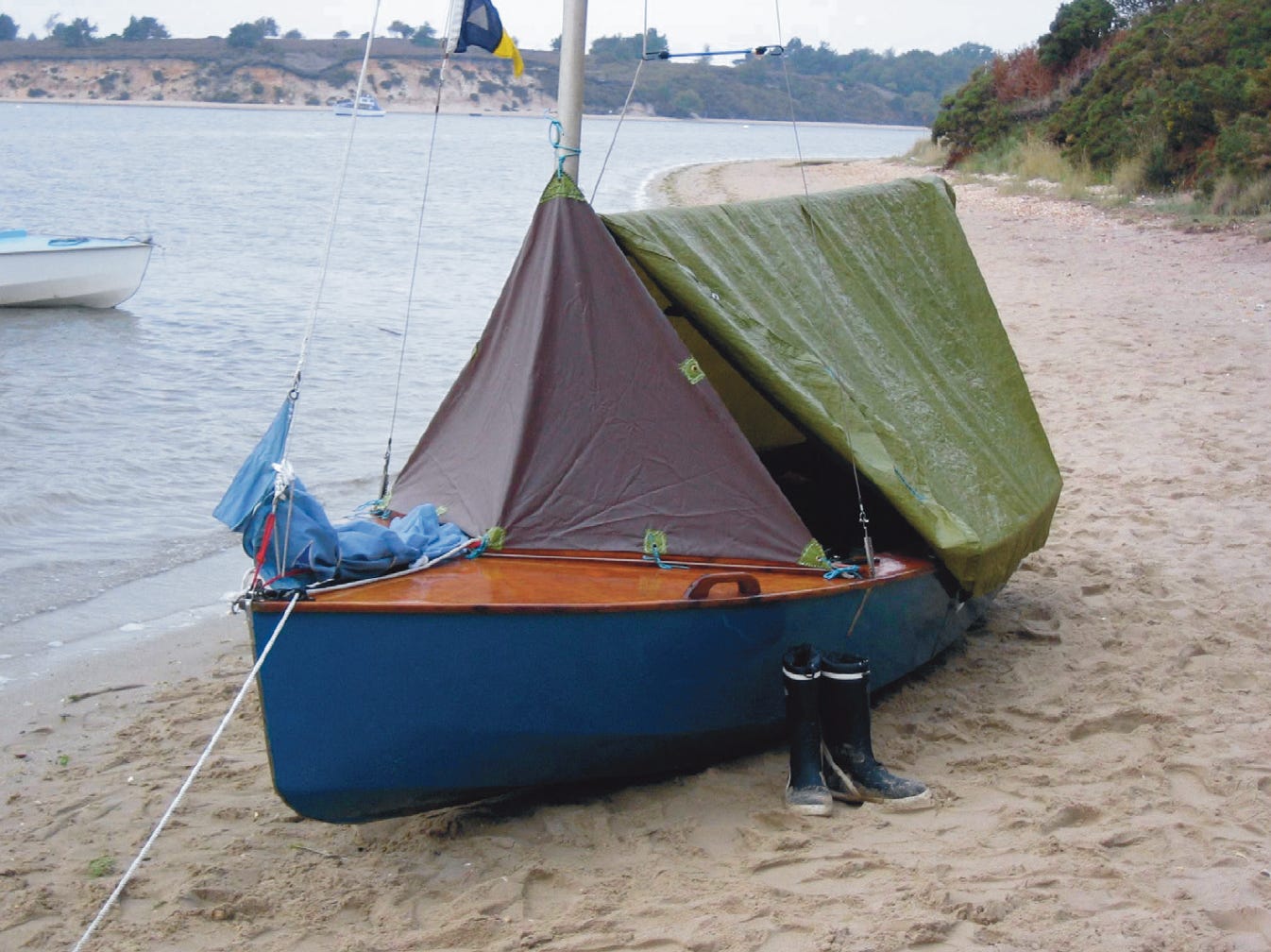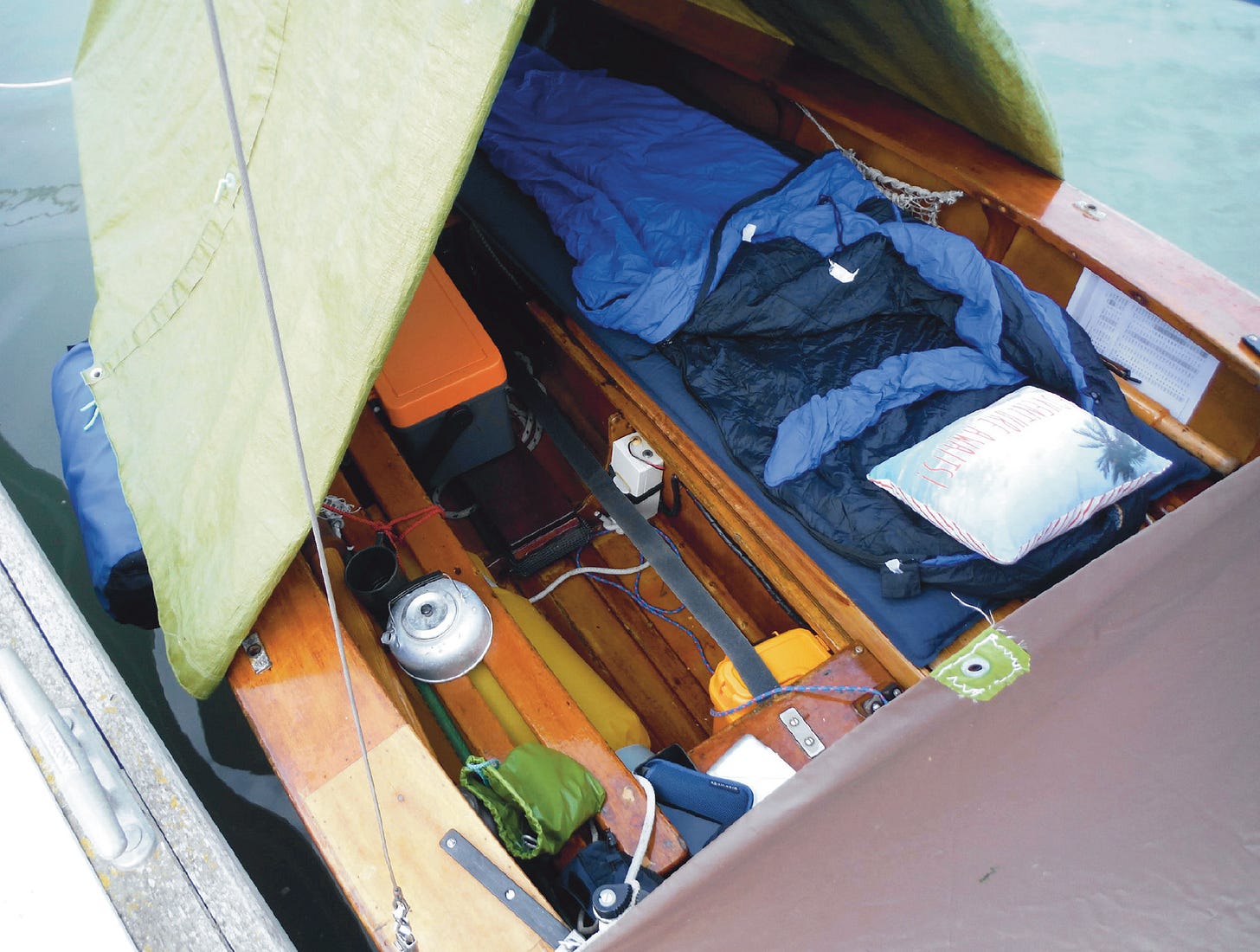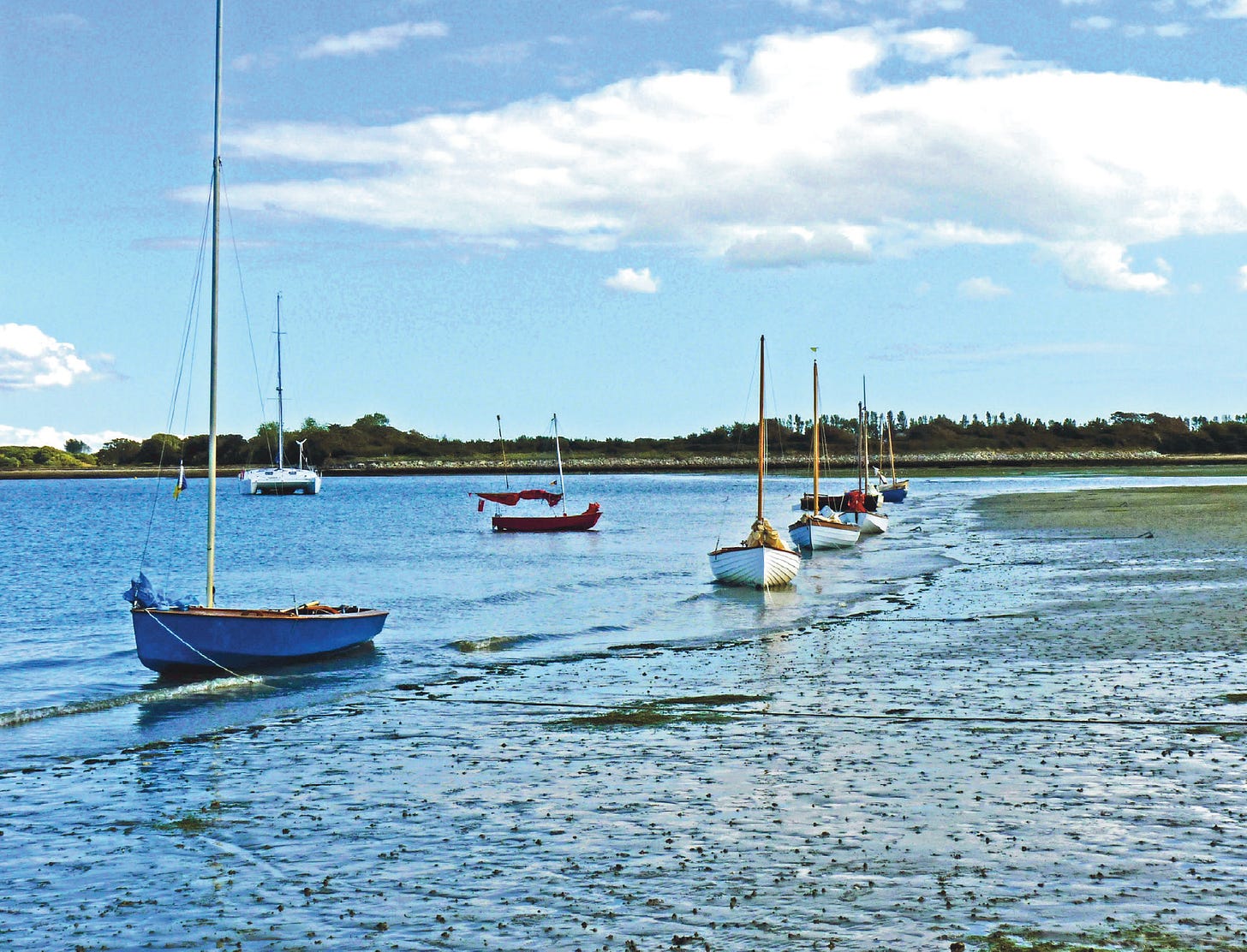Setting up a Sailing Dinghy for Cruising
If you own a dinghy and race it at your local club, can you use the same boat for cruising?
Article by Steve Bradwell
DCA Editor’s Preface:
The ENTERPRISE was designed by Jack Holt in 1956 for the now extinct UK newspaper The News Chronicle. It was followed by the MIRROR dinghy, also designed by Jack Holt and this time backed by The Daily Mirror. They were both conceived as cheap and capable sailboats for “everyman” to build or buy—but that’s where the similarity ends. The Enterprise is a conventional stem dinghy while the Mirror’s defining feature is its shapely bow transom (or “pram bow”). More importantly, the Enterprise was designed to be a fast popular racer from the start with a big sail plan to suit. It is thought to be relatively unstable compared with other boats of similar performance. Unlike the Mirror, the Ent is not a popular choice for cruising and ‘pottering,” despite the availability of a smaller sailplan. Steve Bradwell is one of a select minority. He usually sails his Enterprise with a cruising main and the normal jib.
As a club racer the Enterprise is still a very popular international class. Its size, weight and power—and value for money—add up to a package that has a wide appeal. It is most often raced without a spinnaker, but they are generally seen on this boat in the US.
I have written this prelim because I feel that Steve’s choice of a racer for his cruising boat lends weight to his practical and down to earth advice on how to set up any sailing dinghy for cruising. I see this as a short but seminal article. It corrects the impression that you need expensive equipment or a new boat to go cruising.
—Keith Muscott
The Enterprise Dinghy. Its blue sails are as much a recognised feature as the red sails on a Mirror
If you own a dinghy and race it at your local club, can you use the same boat for cruising, without modifications that will take it out of class? The chances are you can and if it’s a boat people tell you is too “tippy” for cruising, all it may need is an effective way of reducing the sail area. Maybe your boat has a square gooseneck connecting the boom to the mast, in which case you could use roller reefing. Failing that a cheap set of second-hand sails from another class could be used to tame it. There are two reef points on my mainsail. Jiffy lines back to the mast. Previously I had roller reefing using the square gooseneck pin, which was fine, but slab reefing is better.
If that appeals to you, here are some suggestions for additional equipment you might need. How much of it you use will range from almost none for day-cruising on an inland lake to most of it for overnight coastal cruising in unfamiliar waters.
This is my personal gear I carry on my Enterprise and there are plenty of alternative approaches. Nothing is set in stone. As for the smallest boat that can be used, all I can say is that the most popular boat in the DCA South Coast fleet is the 10ft 10inch Mirror, a number of which are used for sleep-aboard cruising.
Enterprise on the beach with a two–piece boat “tent,” using a standard sized poly tarpaulin and a cut-to-shape brown groundsheet
Extra eyelets may need to be added to the tarp for line attachment points. DIY eyelet kits are sold at most chandlers. This system avoids the need for through-hull fittings and is used on my boat. Other methods of attaching the sides of the boat tent are more commonly used but may require some modification to the boat.
Living on board an Enterprise. Most people find boats around this size (13 feet 4 inches), practical only for solo camping aboard. Something around the size of a Wayfarer (15 feet 10 inches) might be more suitable for two.
Bed Boards. Most boats the size of an Enterprise will require bed boards to be made (above) to provide a flat unobstructed area to sleep on. The ones shown lock together to stop them separating and rest on the forward and rear thwarts with a removable channelled cross support which simply sits on top of the centreboard case at one end and a hull stringer at the other. The method will differ greatly according to boat classes and how they are constructed, in wood or fibreglass.
Wooden boat? You need to keep rain water out. This is my solution.
Anchors and warps / cables. You will definitely need an anchor, preferably two for overnight stops. There are endless arguments over which type is best, but these are mine. Remember you may find your anchor attached to the foreshore or dry land as often as the sea bed.
Containers for your gear. Mine range from waterproof, like the screw-on red top watersports tub for stuff that needs to stay dry, such as car keys, phone, etc., to semi-waterproof – the orange box on the left which has a clamp down lid and a rubber seal – in which I keep spare chandlery, navigation stuff and lighting. (It came from a field sports store.)
Lastly, the box on the right is splash proof and contains my camping gear. It’s sold as a tool box and stays dry in most conditions short of a capsize. This one doesn’t have a handle in the lid which is where the water gets into most cheap tool boxes.
Some people make custom fit wooden boxes, which is a nice thing to do and looks good, particularly on a traditional boat. I took the easy route and went plastic. The two large boxes fit under my forward thwart, keeping the floor space clear.
Sleeping bag, mat and spare clothing are stored in roll-top dry bags stuffed up under the foredeck, the driest place on my boat.
Oars. If there is no wind to sail you will need at least a paddle, and oars are better. Mine are home-made from softwood. I have a moveable rowing thwart otherwise I would have to sit on the centreboard. Some carry an outboard, petrol or electric.
Navigation Gear. This shows some of the safety and navigation gear I carry. You won’t necessarily need all these items. I use the binoculars mainly for boat watching and spotting other DCA members. For navigation they are useful to identify buoyage, harbour entrances, etc.
I rarely carry the iPad when sailing the Solent area, which I know well. My phone is also loaded with Navionics charts if I need them. I always have an Ordnance Survey map of the area, which is more useful in a dinghy than it would be in a yacht.
Lighting. An anchor light used when overnighting anywhere other vessels can navigate, plus torch, lantern and/or head torch.
GPS is not essential for inshore sailing unless you are unlucky enough to be out in fog, which should obviously be avoided. I find it useful to know my speed over the ground, which can be difficult to judge on open water.
For coastal sailing a VHF radio is still the best way to get assistance at sea. Occasionally it can be used to call up other DCA members or a harbourmaster. A radio licence is needed through the RYA. A flare; mine is out of date and should be replaced. I'm not sure how many dinghy sailors carry these, but if you need help an orange smoke flare will effectively identify your position. Compass sounds like an obvious thing to have and I always carry one – but I rarely use it. I did check it recently to identify the entrance to Newtown Creek.
Setting up your boat for cruising and acquiring the right kit can take years to get right, as things can always be improved and you, like me, may find it an ongoing and absorbing process.
Steve seen in his Enterprise during a recent blowy South Coast meeting.(Photo taken by Alan Moulton, South Coast Area Secretary; all other photographs taken by Steve Bradwell)
Steve and his Enterprise are seen with other South Coast members at most of their rallies. In this case it is a recent East Head meeting, in Chichester Harbour. The DCA fleet is moored together in line with his Enterprise on the left.
•SCA•













Excellent article broadly applicable to our small boat world. Congratulations and thanks, Mr Bradwell, got me excited!
Great article. I have camp cruised a Penobscot 14, but haven't yet come up with a successful on(a)board sleeping arrangement.
Question: can anyone direct me to small Fisherman's or Herreshoff anchor, as pictured? In the USA, without spending an arm and a leg.
Thank you, Paul